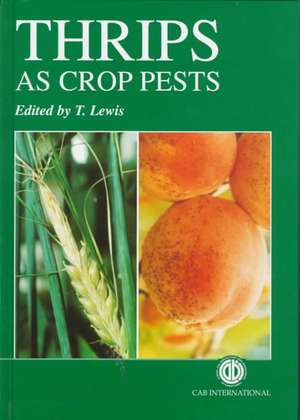Thrips as Crop Pests
Autor Trevor Lewisen Limba Engleză Hardback – 31 oct 1997
Preț: 1191.34 lei
Preț vechi: 1547.20 lei
-23% Nou
Puncte Express: 1787
Preț estimativ în valută:
227.99€ • 247.56$ • 191.51£
227.99€ • 247.56$ • 191.51£
Carte indisponibilă temporar
Doresc să fiu notificat când acest titlu va fi disponibil:
Se trimite...
Preluare comenzi: 021 569.72.76
Specificații
ISBN-13: 9780851991788
ISBN-10: 0851991785
Pagini: 736
Dimensiuni: 172 x 244 x 15 mm
Greutate: 1.55 kg
Editura: CABI
ISBN-10: 0851991785
Pagini: 736
Dimensiuni: 172 x 244 x 15 mm
Greutate: 1.55 kg
Editura: CABI
Recenzii
"The first chapters of this book provide the basic biology, structure and behavior of thrips, particularly pest species. Chapters 7-12 concentrate on population biology and ecology. The articles pertaining to worldwide IPM of thrips, namely Integrated Pest Management in Field Crops, Tree Crops, Glasshouses, and Chemical Control, reflect the state of the art." --IPM Practitioner
"Thrips as Crop Pests is a compendium of 18 chapters on basic biology, research methods, and management of thrips, those minute, haplodiploid, mostly plant-feeding insects that are useful for addressing fundamental questions in biology, but extremely injurious to a tremendous diversity of crops and trees worldwide. . . . Lewis has chosen the contributors wisely, as the chapters are consistently of high quality, comprehensive, and authoritative. . . . This book should be considered essential for all workers studying the biology and management of thrips. Its value rests in drawing together fecund, diverse and obscure literature, which will make the job of studying thrips much easier, more productive, and perhaps more collaborative for many years ahead."--The Quarterly Review of Biology
"Thrips as Crop Pests is a compendium of 18 chapters on basic biology, research methods, and management of thrips, those minute, haplodiploid, mostly plant-feeding insects that are useful for addressing fundamental questions in biology, but extremely injurious to a tremendous diversity of crops and trees worldwide. . . . Lewis has chosen the contributors wisely, as the chapters are consistently of high quality, comprehensive, and authoritative. . . . This book should be considered essential for all workers studying the biology and management of thrips. Its value rests in drawing together fecund, diverse and obscure literature, which will make the job of studying thrips much easier, more productive, and perhaps more collaborative for many years ahead."--The Quarterly Review of Biology
